Gender, Land and Food Access in Ghana’s Suburban Cities: A Case of the Adenta Municipality
Abstract
:1. Introduction: Land and Competitive Urban Transformation
2. Land and Food Access and Gender Imbalance within a Competing Urban Space—The Nexus
2.1. Urban Competition and Land Access
2.2. Women’s Land Rights and Access
2.3. Women and Food Access
2.4. Conceptual Framework
3. Study Area and Methodology
3.1. The Study Area
3.2. Methodology
3.2.1. Weighting and Ranking of Data Indicators
- To normalize all the indicators to matching units and scale, standardized values were calculated using the standard deviation formula as shown in Equation (1):where Z = standardized value, Xi = Indicator value (quantitative data collected on the land use change and access, through questionnaires and PHC data), μ = mean value and σ = standard deviation.Standard Value Z = (Xi − µ)/σ
- The next step was to normalize the standardized indicator values such that the values fell within 0 to 1 in order to facilitate the weighting of the indicators. The normalized standardized value as shown in Equation (2) is defined aswhere Zi lies between a to e, Zi = standard score, a = minimum value, e = maximum value and Y ranges from 0 and 1.Y = (Zi − a)/(e − a)
- Reverse indicators, such as incidence of vulnerability and gender were further standardized using the formula (1 − Y) so that all values nearer or equal to 1 are those approaching food security, while those nearer zero (0) means land insecurity or within the food stress areas.
3.2.2. Weighting and Calculating Aggregate Scores
3.2.3. Using Pairwise to Simulate Land and Food Access Disparities
3.3. The Adoption of Spatial Frameworks and Multiple Evaluation Methods
4. Results and Discussion
4.1. Urban Competition and Land in Adenta Municipality
4.2. Urban Sprawl, Vegetation Loss and Food Declines
4.3. Economic Access
4.4. Social Access
4.5. The Role of Sustainability Food Frameworks in Urban and Suburban Districts
4.6. The Complex Nature of the Land and Food Disparity
4.7. Land and Food System Dynamics in the Adenta Sub-City
5. Conclusions
Author Contributions
Funding
Acknowledgments
Conflicts of Interest
References
- Farvacque-Vitkovic, C.; Raghunath, M.; Eghoff, C.; Boakye, C. Development of the Cities of Ghana: Challenges, Priorities and Tools; Africa Region Working Paper Series; The World Bank: Washington, DC, USA, 2008. [Google Scholar]
- Anand, S.; Jagadeesh, K.; Adelina, C.; Koduganti, J. Urban food insecurity and its determinants: A baseline study of Bengaluru. Environ. Urban. 2019, 31, 421–442. [Google Scholar] [CrossRef]
- Tefft, J.; Jonasova, M.; Adjao, R.; Morgan, A. Food Systems for an Urbanizing World—Knowledge Product; The World Bank: Washington, DC, USA, 2017. [Google Scholar]
- Oduro, C.Y.; Adamtey, R. The Vulnerability of Peri-Urban Farm Households with the Emergence of Land Markets In Accra. J. Sci. Technol. 2017, 37, 85–100. [Google Scholar]
- United Nations UN. Transforming our World: The 2030 Agenda for Sustainable Development; Division for Sustainable Development Goals: New York, NY, USA, 2015. [Google Scholar]
- New Urban Agenda—Habitat III. Available online: https://habitat3.org/the-new-urban-agenda/ (accessed on 15 October 2020).
- Ghana Statistical Service (GSS). Population and Housing Census; Ghana Statistical Service (GSS): Accra, Ghana, 2012.
- Kuusaana, E.D.; Kidido, J.K.; Halidu-Adam, E. Customary Land Ownership and Gender Disparity, Evidence from the Wa Municipality of Ghana. Ghana J. Dev. Stud. 2013, 10, 63–80. [Google Scholar] [CrossRef] [Green Version]
- Rünger, M. Governance, Land Rights and Access to Land in Ghana—A Development Perspective on Gender Equity. In Proceedings of the 5th FIG Regional Conference, Marrakech, Morocco, 18–22 May 2011; FIG: Accra, Ghana, 2011. [Google Scholar]
- Asiama, S.O. Crossing the Barrier of Time. The Asante Woman in Urban Land Development. Afr. Riv. Trimest. di Stud. e Doc. Dell’istituto Ital. per l’Africa e l’Oriente 1997, 52, 212–236. [Google Scholar]
- Lambrecht, I.B. As a Husband I Will Love, Lead, and Provide. Gendered Access to Land in Ghana. World Dev. 2016, 88, 188–200. [Google Scholar] [CrossRef] [Green Version]
- Dery, I. Access to and Control over Land as Gendered: Contextualising Women’s Access and Ownership Rights of Land in Rural Ghana. Africanus 2015, 45, 28–48. [Google Scholar] [CrossRef]
- USAID. Gender Analysis Report; USAID: Washington, DC, USA, 2020.
- Arko-Adjei, A. Adapting Land Administration to the Institutional Framework of Customary Tenure. Ph.D. Thesis, Delft University of Technology, Delft, The Netherlands, 2011. [Google Scholar]
- Kalabamu, F.T. Divergent paths: Customary land tenure changes in Greater Gaborone, Botswana. Habitat Int. 2014, 44, 474–481. [Google Scholar] [CrossRef]
- Ubink, J.M.; Quan, J.F. How to combine tradition and modernity? Regulating customary land management in Ghana. Land Use Policy 2008, 25, 198–213. [Google Scholar] [CrossRef]
- Abdulai, R.T.; Ndekugri, I.E. Customary landholding institutions and housing development in urban centres of Ghana: Case Studies of Kumasi and Wa. Habitat Int. 2007, 31, 257–267. [Google Scholar] [CrossRef]
- Kuusaana, E.D.; Eledi, J.A. Customary land allocation, urbanization and land use planning in Ghana: Implications for food systems in the Wa Municipality. Land Use Policy 2015, 48, 454–466. [Google Scholar] [CrossRef]
- Namubiru-Mwaura, E. Land Tenure and Gender: Approaches and Challenges for Strengthening Rural Women’s Land Rights; Women’s Voice, Agency, & Participation Research Series; World Bank Group: Washington, DC, USA, 2014. [Google Scholar]
- Acheampong, R.A. Urbanization and Settlement Growth Management. 2019, pp. 171–203. Available online: https://link.springer.com/chapter/10.1007/978-3-030-02011-8_9 (accessed on 10 October 2020).
- Twum-Baah, K.A. Population growth of Mega-Accra—Emerging issues. In Visions of the City: Accra in the 21st Century; Mills-Tettey, R., Adi-Dako, K., Eds.; Woeli Publishing Services: Accra, Ghana, 2000. [Google Scholar]
- Higgins, T.; Fenrich, J. Legal Pluralism, Gender, and Access to Land in Ghana. Forham Environ. Law Rev. 2012, 23, 7–12. [Google Scholar]
- Kasanga, K.R.; Kotey, N.A. Land Management in Ghana: Building on Tradition and Modernity; IIED: London, UK, 2001. [Google Scholar]
- Mireku, K.O.; Kuusaana, E.D.; Kidido, J.K. Legal implications of allocation papers in land transactions in Ghana—A case study of the Kumasi traditional area. Land Use Policy 2016, 50, 148–155. [Google Scholar] [CrossRef]
- Asiama, K.O.; Bennett, R.M.; Zevenbergen, J.A. Participatory Land Administration on Customary Lands: A Practical VGI Experiment in Nanton, Ghana. ISPRS Int. J. Geo-Inf. 2017, 6, 186. [Google Scholar] [CrossRef] [Green Version]
- Alden Wily, L. Custom and commonage in Africa rethinking the orthodoxies. Land Use Policy 2008, 25, 43–52. [Google Scholar] [CrossRef]
- Magigi, W.; Drescher, A.W. The dynamics of land use change and tenure systems in Sub-Saharan Africa cities; learning from Himo community protest, conflict and interest in urban planning practice in Tanzania. Habitat Int. 2010, 34, 154–164. [Google Scholar] [CrossRef]
- Jat, M.K.; Garg, P.K.; Khare, D. Monitoring and modelling of urban sprawl using remote sensing and GIS techniques. Int. J. Appl. Earth Obs. Geoinf. 2008, 10, 26–43. [Google Scholar] [CrossRef]
- Bhanjee, S.; Zhang, C.H. Mapping Latest Patterns of Urban Sprawl in Dar es Salaam, Tanzania. Pap. Appl. Geogr. 2018, 4, 292–304. [Google Scholar] [CrossRef]
- Bowyer, D. Measuring Urban Growth, Urban Form and Accessibility as Indicators of Urban Sprawl in Hamilton, New Zealand. Master’s Thesis, Lund University, Lund, Sweden, 2015. [Google Scholar]
- Twum, K.O.; Ayer, J. Connecting the complex dots: A review of urban change complexities in Ghana. Cogent Soc. Sci. 2019, 5, 1677119. [Google Scholar] [CrossRef]
- Appiah, J.A. Gender Differences in Access to, and Use of, Farmlands: A Case Study of Abokobi in the Ga East Municipality. Ph.D. Thesis, University of Ghana, Accra, Ghana, 2015. [Google Scholar]
- Danso, G.; Cofie, O.; Annang, L.; Obuobie, E.; Keraita, B. Gender and Urban Agriculture: The Case of Accra, Ghana; Resource Centre on Urban Agriculture and Forestry: Accra, Ghana, 2004. [Google Scholar]
- Asiama, K.O.; Lengoiboni, M.; van der Molen, P. In the Land of the Dammed: Assessing Governance in Resettlement of Ghana’s Bui Dam Project. Land 2017, 6, 80. [Google Scholar] [CrossRef] [Green Version]
- Kalabamu, F.T. Patriarchy and women’s land rights in Botswana. Land Use Policy 2006, 23, 237–246. [Google Scholar] [CrossRef]
- Yngstrom, I. Women, Wives and Land Rights in Africa: Situating Gender Beyond the Household in the Debate Over Land Policy and Changing Tenure Systems. Oxf. Dev. Stud. 2002, 30, 21–40. [Google Scholar]
- Knox, A.; Duvvury, N.; Milici, N. Connecting Rights to Reality: A Progressive Framework of Core Legal Protections for Women’s Property Rights; International Center for Research on Women (ICRW): Washington, DC, USA, 2007. [Google Scholar]
- Pinstrup-Andersen, P. Food security: Definition and measurement. Food Secur. 2009, 1, 5–7. [Google Scholar]
- van der Molen, P. Food security, land use and land surveyors. Surv. Rev. 2017, 49, 147–152. [Google Scholar]
- WFP. World Hunger Series: Hunger and Markets; World Food Programme: Rome, Italy, 2009. [Google Scholar]
- Rockson, G.; Bennett, R.; Groenendijk, L. Land administration for food security: A research synthesis. Land Use Policy 2013, 32, 337–342. [Google Scholar]
- Crush, J.S.; Frayne, G.B. Urban food insecurity and the new international food security agenda. Dev. South. Afr. 2011, 28, 527–544. [Google Scholar]
- Crush, J.; Caesar, M. City without choice: Urban food insecurity in Msunduzi, South Africa. Urban Forum 2014, 26, 165–175. [Google Scholar]
- Chen, S.; Ravallion, M. The Developing World Is Poorer Than We Thought, But No Less Successful in the Fight against Poverty; The World Bank: Washington, DC, USA, 2008. [Google Scholar]
- Lacey, E.J. Understanding The Livelihoods Of Women In The Local Foodscape: A Case Study of Accra, Ghana. Master’ Thesis, University of Oregon, Eugene, Oregon, 2010. [Google Scholar]
- Agana, C. Women’s Land Rights and Access to Credit in a Predominantly Patrilineal System of Inheritance: Case Study of The Frafra Traditional Area, Upper East Region. Ph.D. Thesis, KNUST, Kumasi, Ghana, 2012. [Google Scholar]
- Simon, D.; McGregor, D.; Thompson, D. The search for peri-urban resources sustainability. In The Peri-Urban Interface: Approaches to Sustainable Natural and Human Resource Use; Simon, D., McGregor, D., Thompson, D., Eds.; Sinica: London, UK, 2006; pp. 1–17. [Google Scholar]
- Adentan Municipal Assembly. Medium Term Development Report. Adenta, Ghana. 2017. Available online: https://new-ndpc-static1.s3.amazonaws.com/CACHES/PUBLICATIONS/2016/04/04/GR_Adentan+Municipal_2014-2017+MTDP.pdf (accessed on 31 October 2020).
- Acheampong, R.A. Spatial Planning in Ghana; The Urban Book Series; Springer: Cham, Switzerland, 2019; ISBN 978-3-030-02010-1. [Google Scholar]
- COHRE. Bringing Equality Home: Promoting and Protecting the Inheritance Rights of Women: A Survey of Law and Practice in Sub-Saharan Africa; Centre on Housing Rights and Evictions: Geneva, Switzerland, 2004. [Google Scholar]
- Capaldo, J.; Karfakis, P.; Knowles, M.; Smulders, M. A model of vulnerability to food insecurity. 2010. [Google Scholar] [CrossRef]
- FAO. Regional Overview of Food Security and Nutrition in Africa 2017; FAO: Rome, Italy, 2017. [Google Scholar]
- Torvikey, G.D. Strengthening Women’s Voices in the Context of Agricultural Investments: Lessons from Ghana. Accra/London. 2016. Available online: https://pubs.iied.org/pdfs/12591IIED.pdf (accessed on 10 October 2020).
- Saaty, T.L. A scaling method for priorities in hierarchical structures. J. Math. Psychol. 1977, 15, 234–281. [Google Scholar]
- Saran, S.; Ramana, K.V. Site Suitability Analysis for Industries Using Gis and Multi Criteria Decision Making. ISPRS Ann. Photogramm. Remote Sens. Spat. Inf. Sci. 2018, IV-5, 447–454. [Google Scholar]
- Hagai, M. Food Security Modeling Using Geographic Information Systems (GIS) Techniques: A Strategy Towards Reliable Food Security Information & Early Warning Systems (FSIEWS) for Tanzania. J. L. Adm. East. Afr. 2014, 2, 130945610. [Google Scholar]
- Darfour, B.; Rosentrater, K.A. Agriculture and Food Security in Ghana. In Proceedings of the 2016 ASABE International Meeting, Orlando, FL, USA, 17–20 July 2016; American Society of Agricultural and Biological Engineers: St. Joseph, MI, USA, 2016. [Google Scholar]
- FAO, R. and W.B. Urban Food Systems Diagnostic and Metrics Framework, Roadmap for Future Geospatial and Big Data Analytics; World Bank: Washington, DC, USA, 2017. [Google Scholar]
- GSS. Ghana Living Standards Survey (GLSS6). 2012. Available online: https://www.ilo.org/surveyLib/index.php/catalog/466/stuady-description (accessed on 10 October 2020).
- Dubbeling, M.; Renting, H.; Hoekstra, F.; Wiskerke, J.S.C.; Carey, J. City Region Food Systems. Urban Agriculture Magazine, 29 May 2015. [Google Scholar]
- Potere, D.; Schneider, A. A critical look at representations of urban areas in global maps. GeoJournal 2007, 69, 55–80. [Google Scholar] [CrossRef]
- The World Bank. Urban Agriculture, Findings from Four City Case studies; The World Bank: Washington, DC, USA, 2013. [Google Scholar]
- FAO. Rome Declaration on World Food Security; FAO: Rome, Italy, 1996. [Google Scholar]
- United Nations. Open Working Group Proposal for Sustainable Development Goals; United Nations: New York, NY, USA, 2015. [Google Scholar]
- Yankson, P.W.K. Urbanisation Industrialisation and National Development: Challenges and Prospects of Economic Reform and Globalisation; Ghana Universities Press: Accra, Ghana, 2006. [Google Scholar]
| 1 | The stool (southern Ghana) and the skin (northern Ghana) is a body corporate (like the British crown) representing the people and headed by the chief. |
| 2 | Sample size was limited as a result of the time constraint factor of the research. |
| 3 | Exchange rate used $1 = Ghc 5.5. |
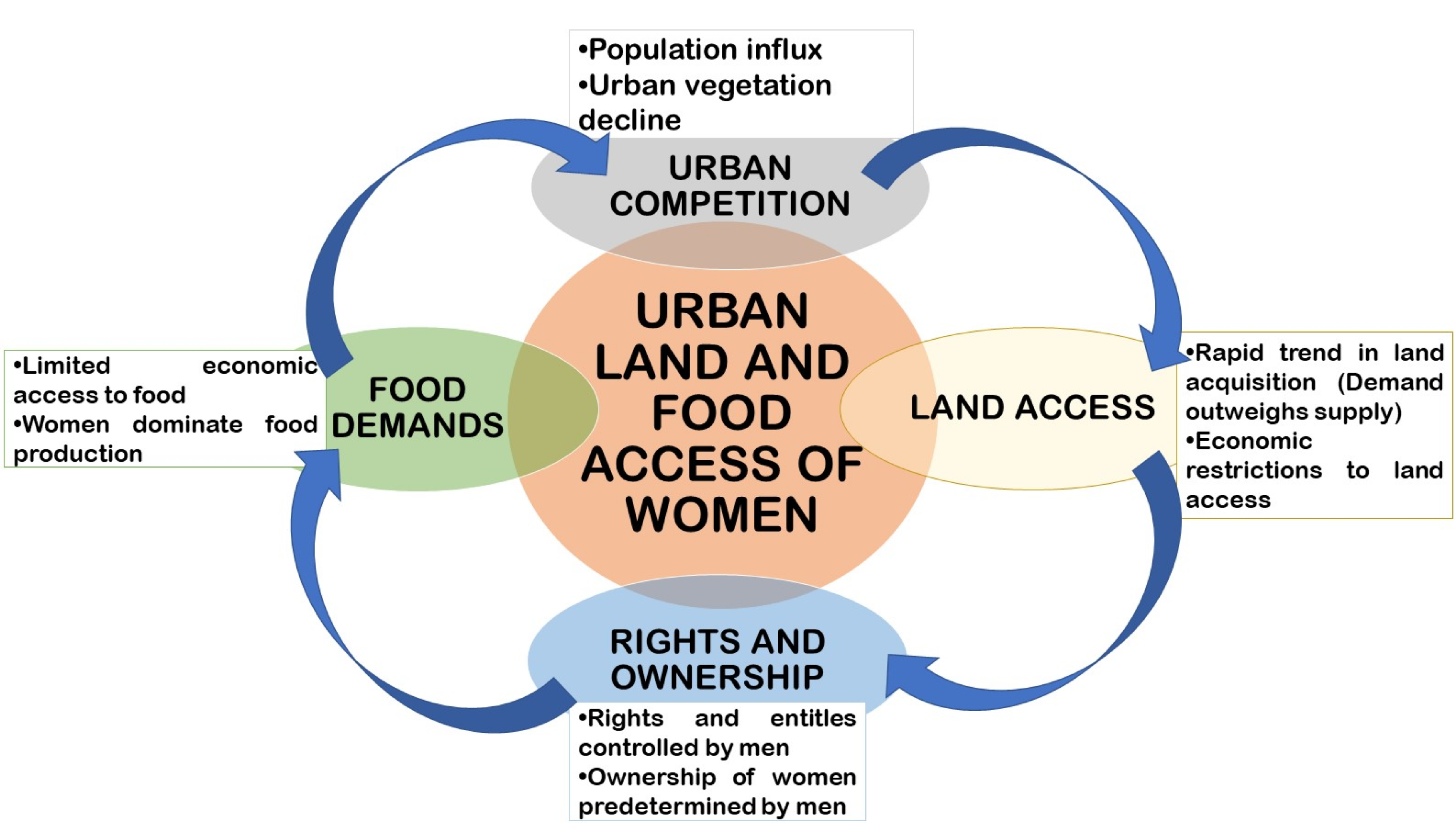
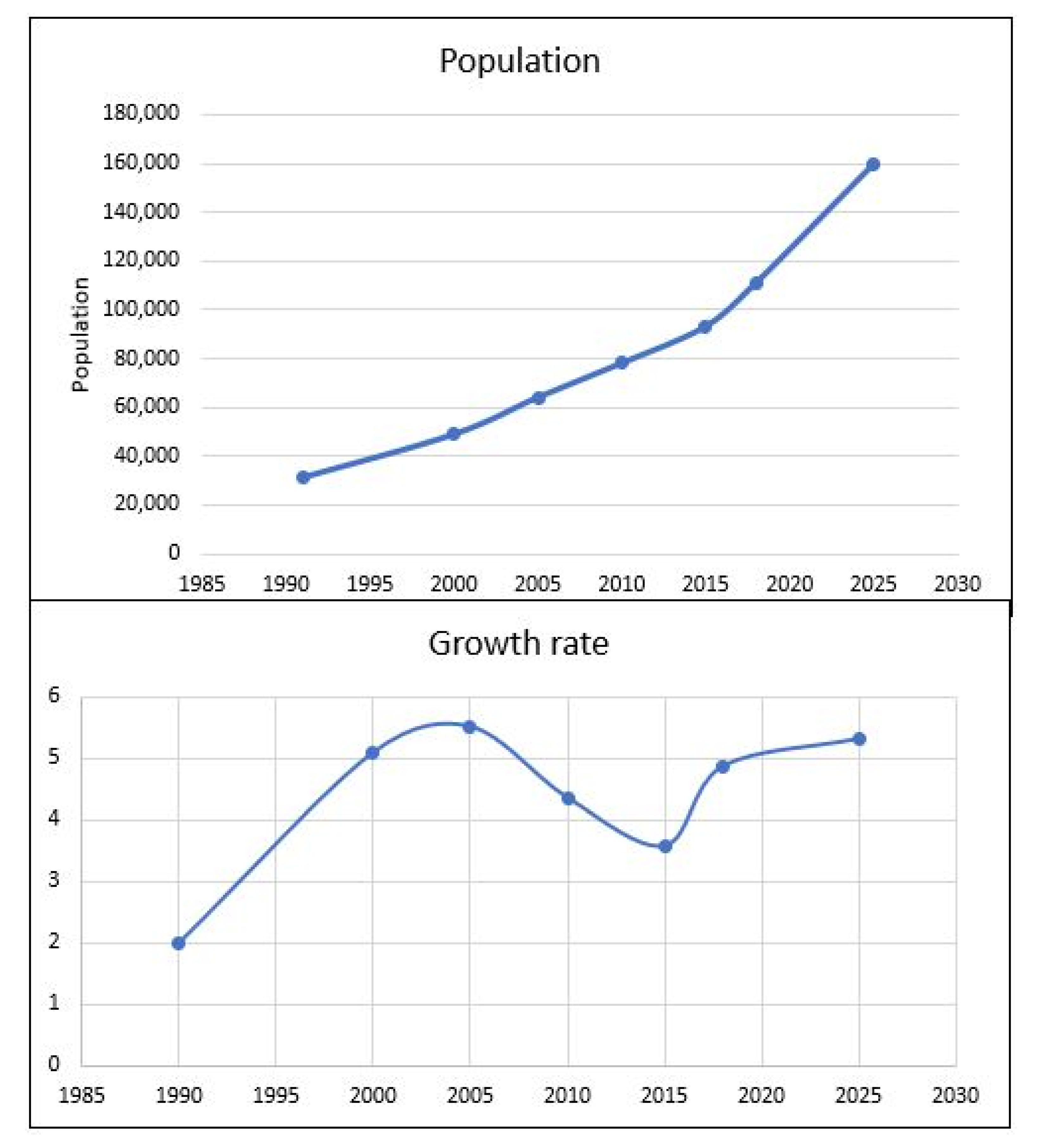
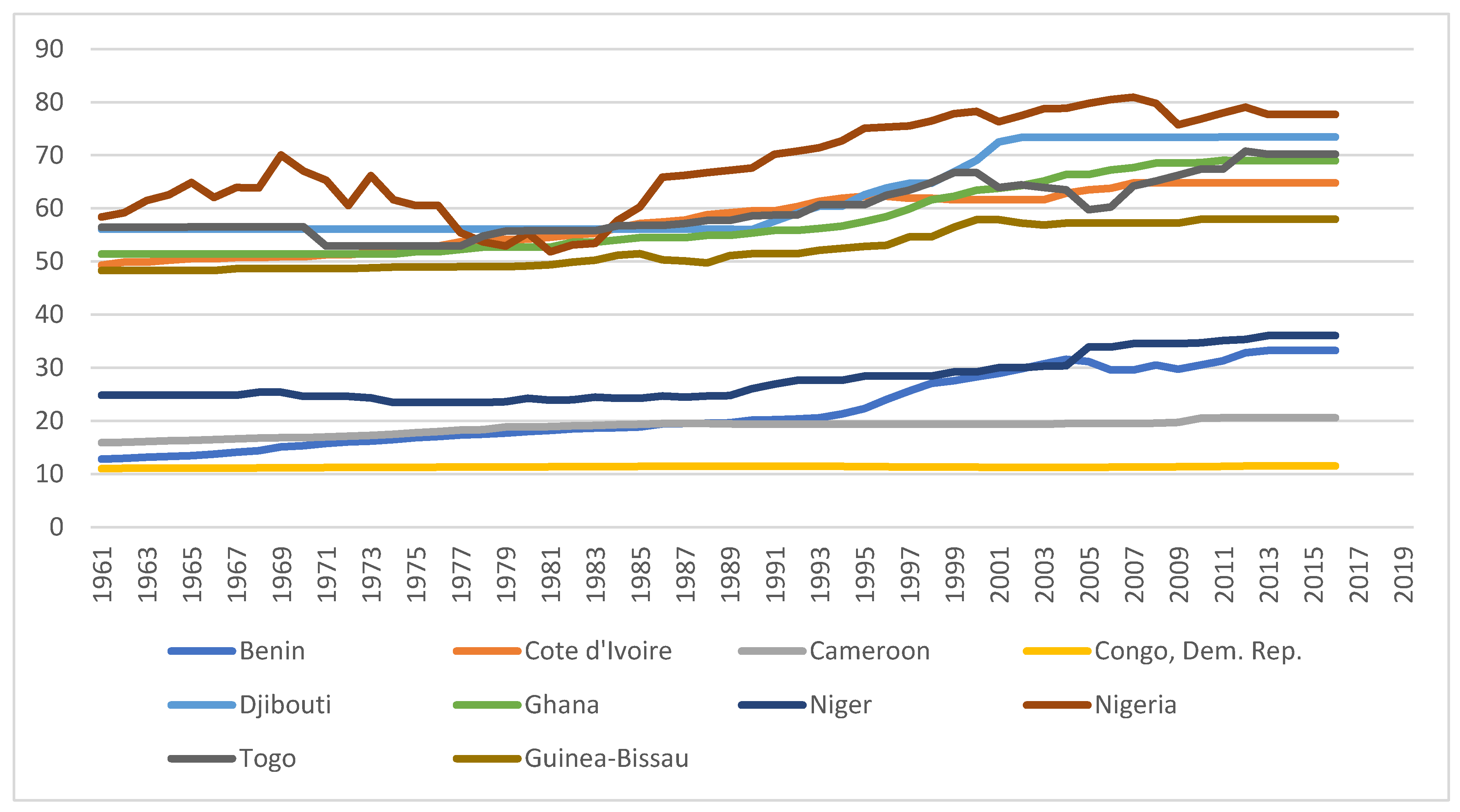
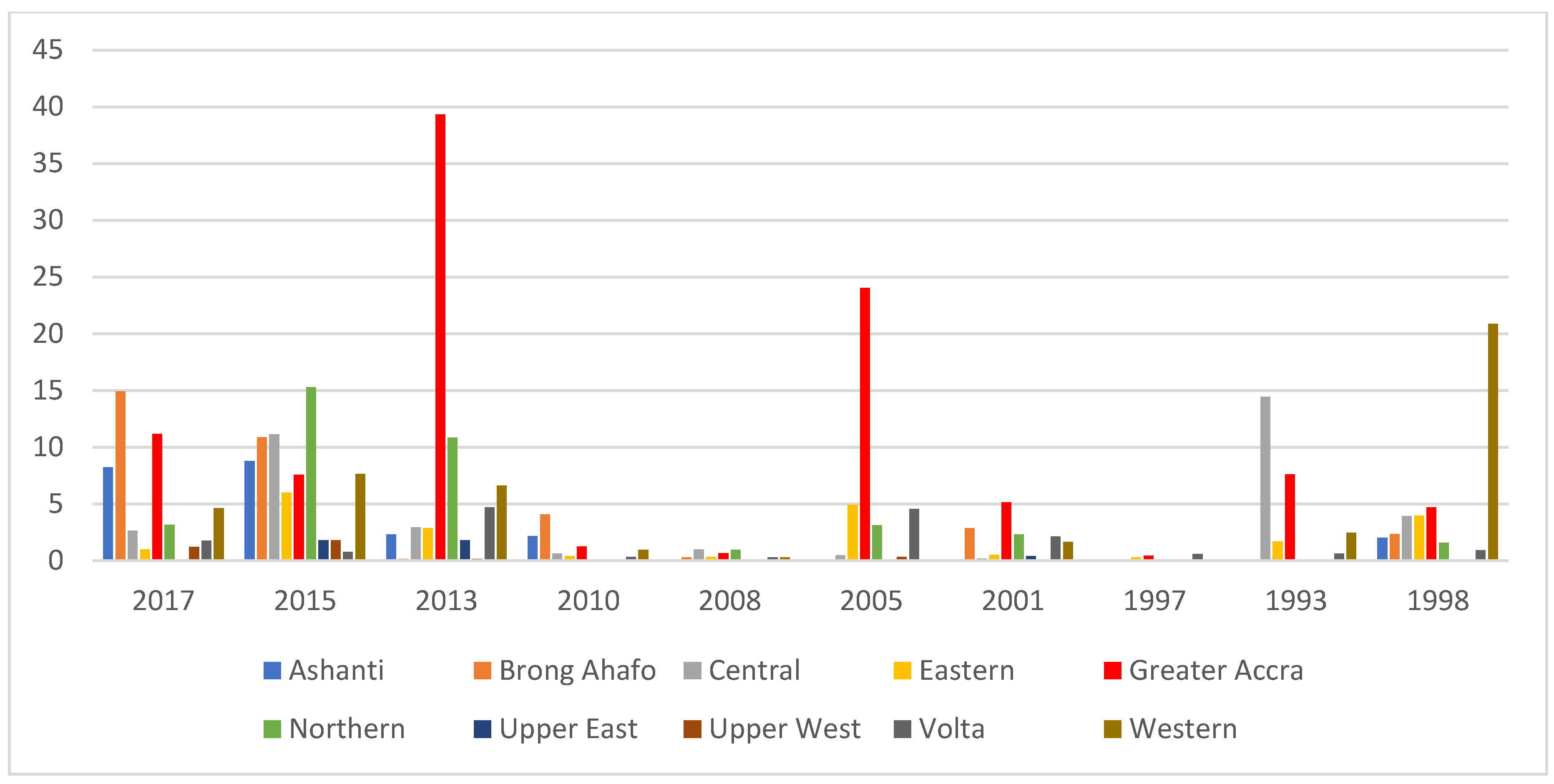
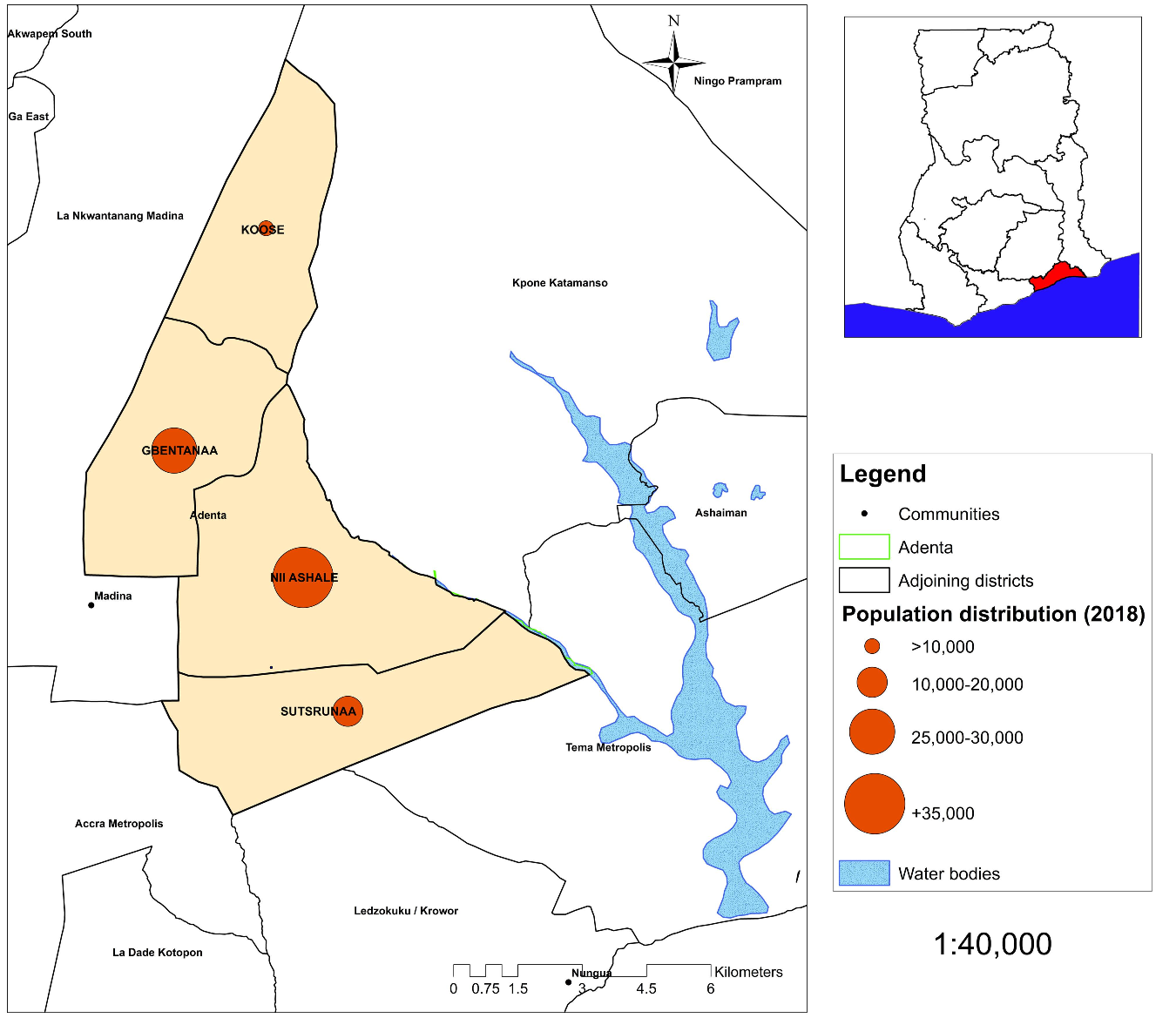
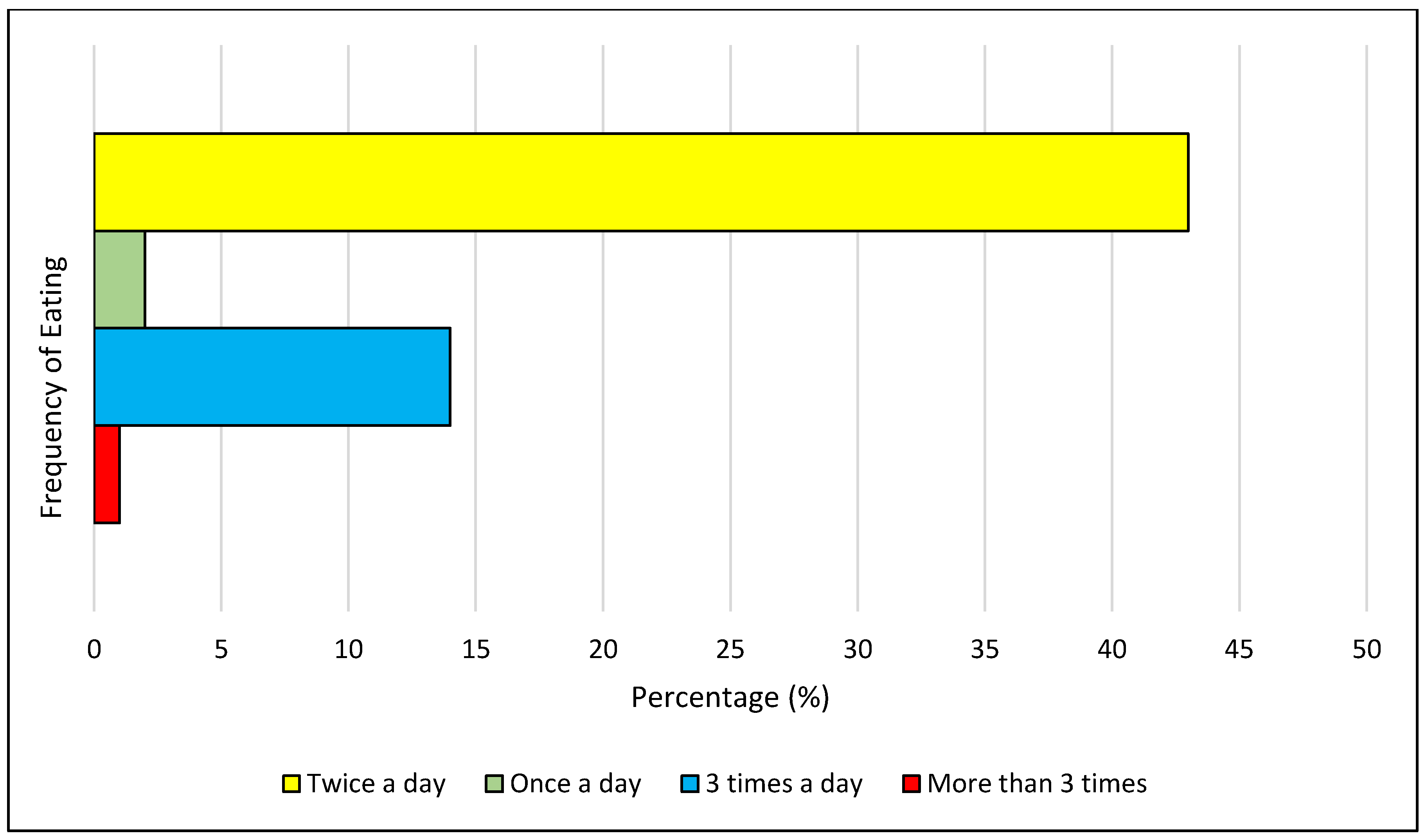

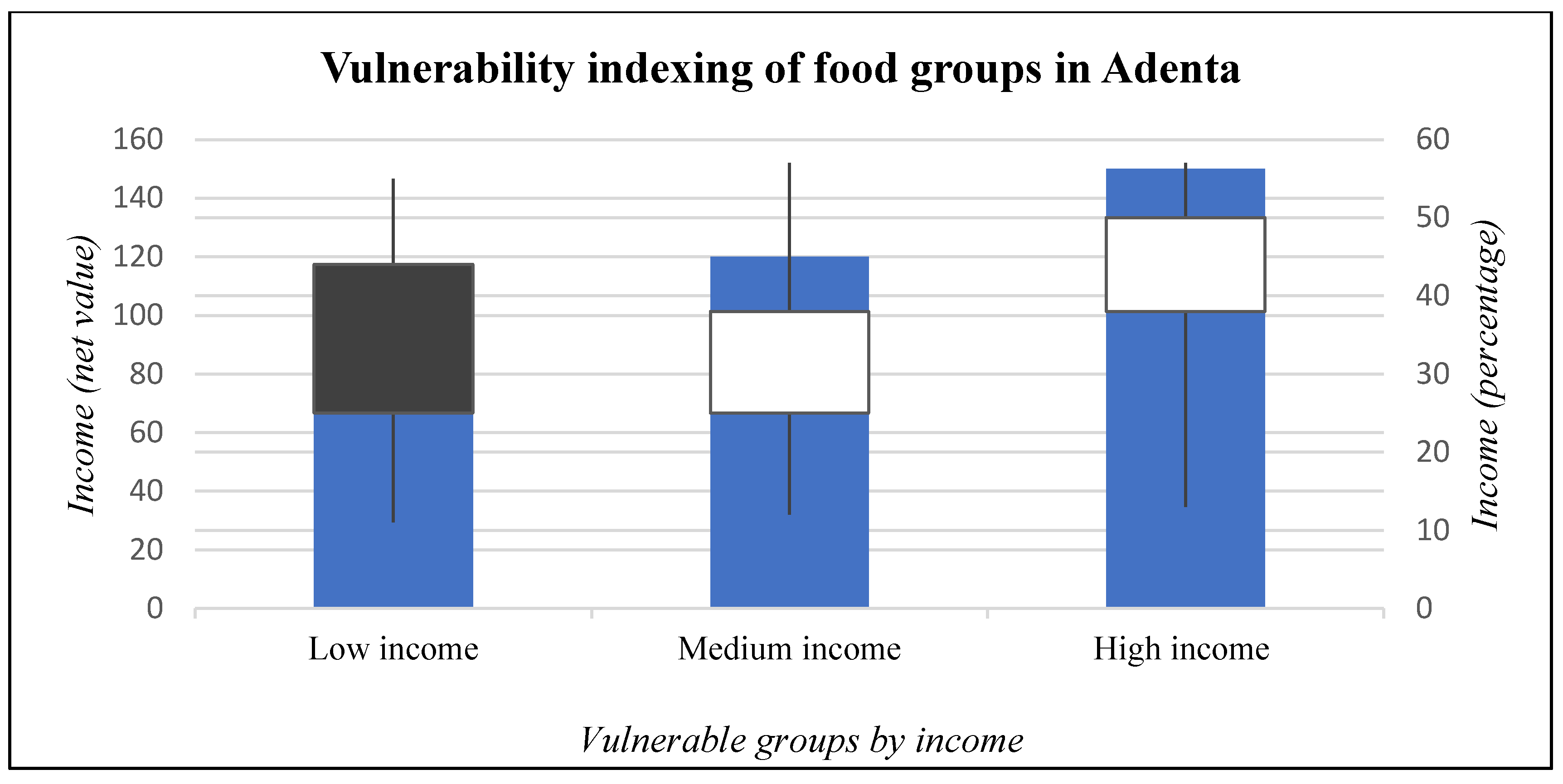

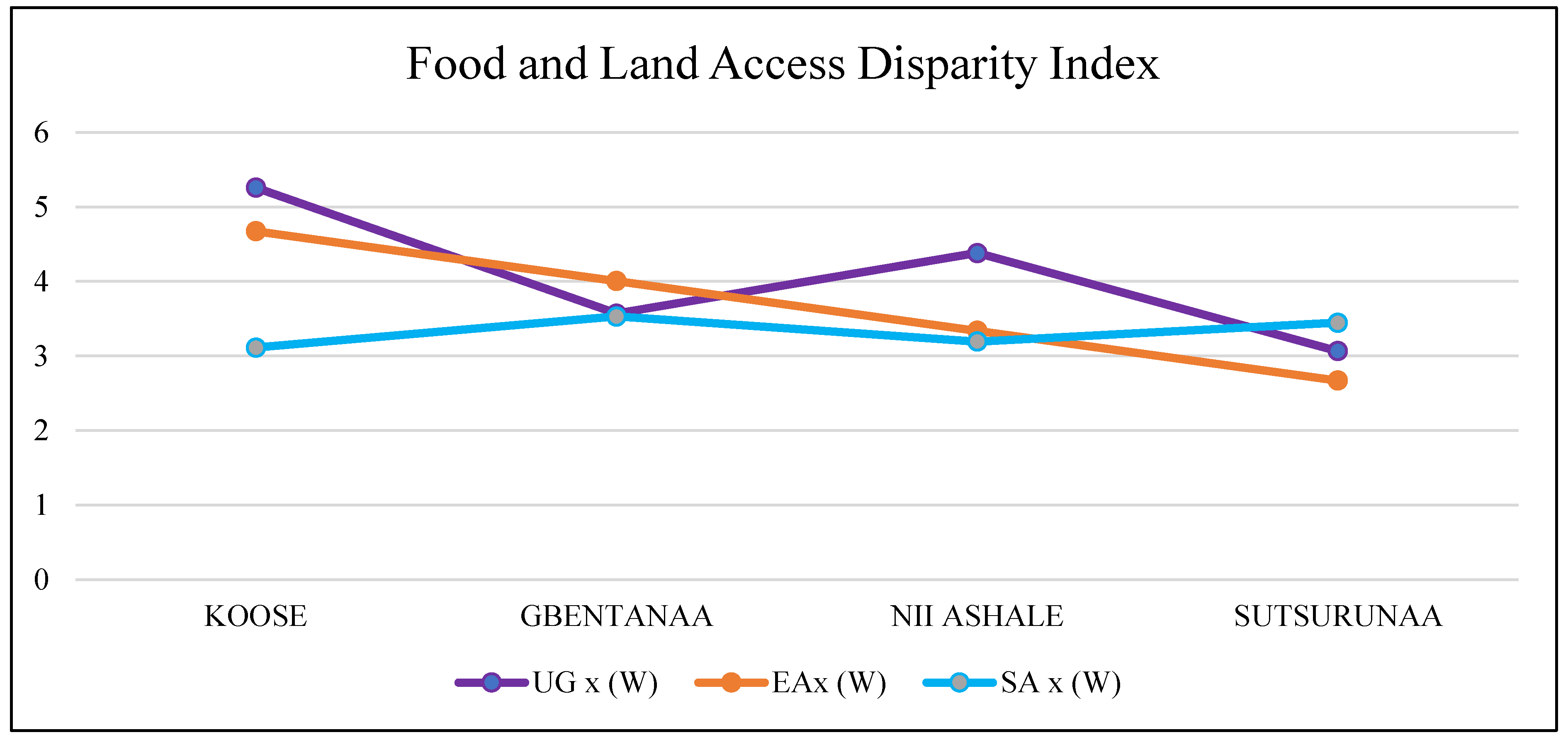
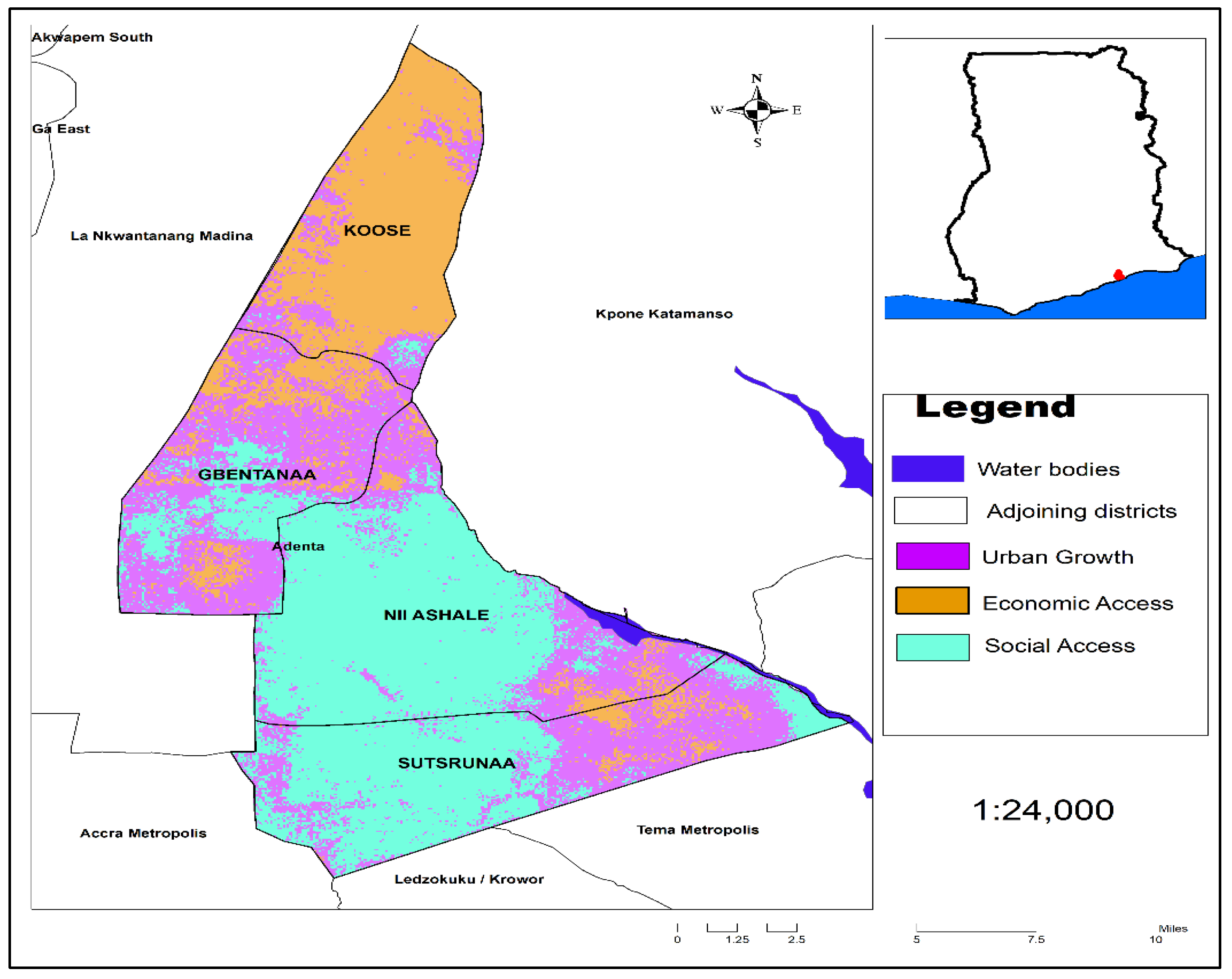
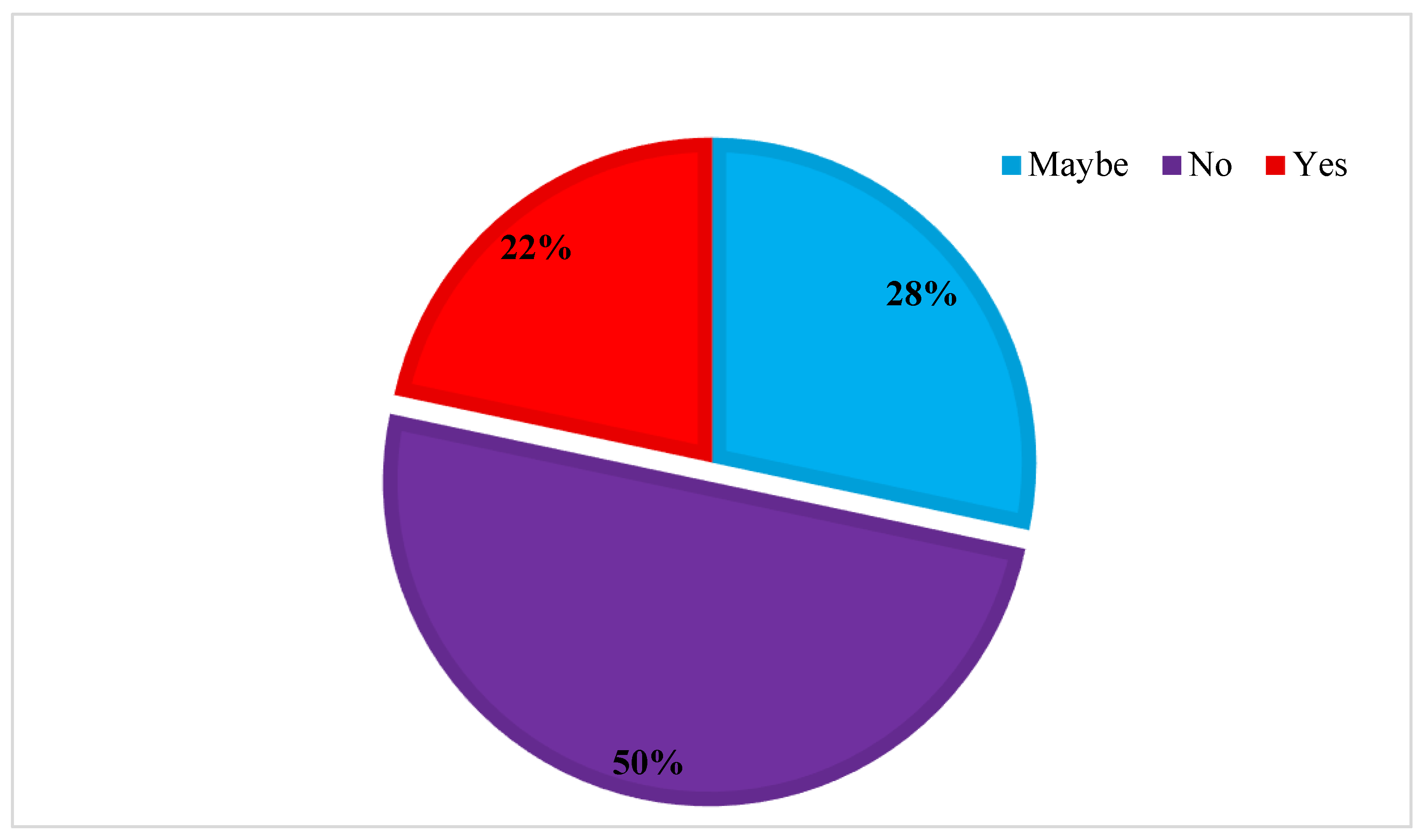
| MUNICIPAL ZONES | Sample Communities | Number of Respondents * |
|---|---|---|
| KOOSE | Amrahia | 15 |
| Gbentanaa | Adenta Old Town and Housing Estate | 15 |
| Nii Ashale | Ashale Botwe | 15 |
| Sutsrunaa | Nmai Djorn | 15 |
| Pairwise Comparison—Criteria Comparison Matrix © | ||||
|---|---|---|---|---|
| Urban Growth | Economic Access | Social Access | Total | |
| Urban Growth | 1.000 | 0.140 | 3.000 | 4.140 |
| Economic Access | 7.000 | 1.000 | 5.000 | 13.000 |
| Social Access | 0.330 | 0.140 | 1.000 | 1.470 |
| Sum columns | 8.330 | 1.280 | 9.000 | |
| Variables | Description | |||
| 1 | Equal importance | |||
| 3 | Moderate importance | |||
| 5 | Strong importance | |||
| 7 | Very strong importance | |||
| 9 | Extreme importance | |||
| 2,4,6,8 | Intermediate values between adjacent scale values | |||
| Municipal Zones | 1991 | 2000 | 2005 | 2010 | 2015 | 2018 |
|---|---|---|---|---|---|---|
| Koose | 2686 | 4282 | 5511 | 6995 | 27,436 | 33,631 |
| Gbentanaa | 9274 | 14,432 | 18,974 | 23,009 | 8341 | 9938 |
| Nii Ashale | 9898 | 15,414 | 20,198 | 24,535 | 29,256 | 34,852 |
| Sutsurunaa | 9499 | 14,942 | 19,511 | 23,676 | 28,231 | 32,684 |
| Total | 31,357 | 49,070 | 64,194 | 78,215 | 93,264 | 111,105 |
Publisher’s Note: MDPI stays neutral with regard to jurisdictional claims in published maps and institutional affiliations. |
© 2020 by the authors. Licensee MDPI, Basel, Switzerland. This article is an open access article distributed under the terms and conditions of the Creative Commons Attribution (CC BY) license (http://creativecommons.org/licenses/by/4.0/).
Share and Cite
Twum, K.O.; Asiama, K.; Ayer, J.; Asante, C.Y. Gender, Land and Food Access in Ghana’s Suburban Cities: A Case of the Adenta Municipality. Land 2020, 9, 427. https://doi.org/10.3390/land9110427
Twum KO, Asiama K, Ayer J, Asante CY. Gender, Land and Food Access in Ghana’s Suburban Cities: A Case of the Adenta Municipality. Land. 2020; 9(11):427. https://doi.org/10.3390/land9110427
Chicago/Turabian StyleTwum, Kwaku Owusu, Kwabena Asiama, John Ayer, and Cosmas Yaw Asante. 2020. "Gender, Land and Food Access in Ghana’s Suburban Cities: A Case of the Adenta Municipality" Land 9, no. 11: 427. https://doi.org/10.3390/land9110427






